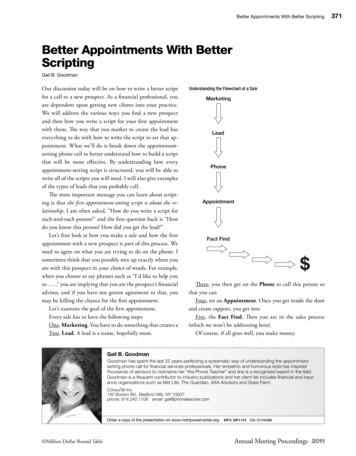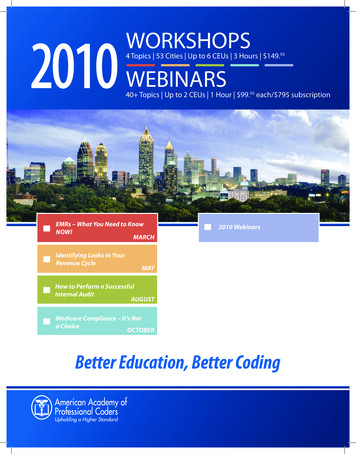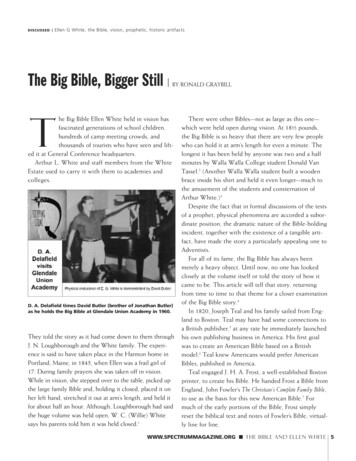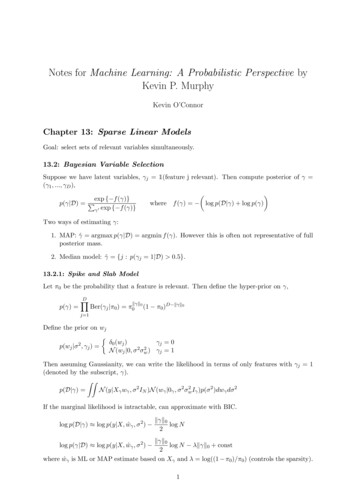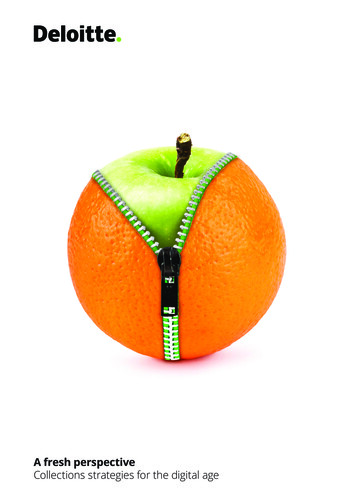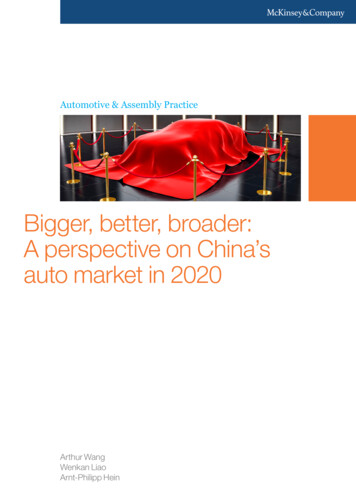
Transcription
Automotive & Assembly PracticeBigger, better, broader:A perspective on China’sauto market in 2020Arthur WangWenkan LiaoArnt-Philipp Hein
Automotive & Assembly PracticeBigger, better, broader:A perspective on China’sauto market in 2020Arthur WangWenkan LiaoArnt-Philipp Hein
Automotive & Assembly PracticeBigger, better, broader: A perspective on China’s auto market in 2020Bigger, better, broader:A perspective on China’s auto market in 2020China’s automotive sector grew at a compound average rate of 24 percent a year between2005 and 2011 and, in 2010, overtook the United States as the largest single-country, newcar market. We forecast that the growth of China’s auto market will slow to an average of8 percent a year between 2011 and 2020 – still very fast by developed-world standards.Sales are forecast to reach 22 million in 2020, bigger than either the European or NorthAmerican markets.As the years pass and the market matures, Chinese consumers are growing moresophisticated about cars and their tastes are evolving. Many have already purchased afirst, entry-level car and will be ready to upgrade to newer and better models. To succeedin this more demanding environment, automakers must better understand what theircustomers want, and how their expectations differ from region to region and from autobody-type segment to segment. In this way, the Chinese car market is becoming morelike that of North American, Europe, and Japan and perhaps even more complex, giventhe many regional and segment differences. To address the need for deeper insights,McKinsey has developed detailed demand forecasts through 2020 of Chinese autocustomers by region and segment. In the analysis, we identified fundamental driversfor demand growth such as increasing urbanization, rising household income, low carpenetration rates, and infrastructure improvements.The following trends will shape the Chinese auto market in the next 10 years, according toour analysis: Going bigger: Sales of sport utility vehicles (SUVs) will triple, although sedans will remainthe largest segment Trading up: There will be more second-time buyers, and they will buy more high-pricedcars High volatility: The volatile growth rates for new cars observed over the last two decadesare likely to continue Regional differences: Consumer behavior by region and car-model preference will varygreatlyOur findings, detailed below, have significant implications for automakers. For example,they will have to place their bets on specific market segments and decide in which cityclusters they should focus their efforts to take advantage of the “going bigger” and“trading up” trends. They will also have to be agile and flexible to react to the marketvolatility.Where the market is headedNew car sales in China are forecast to contribute 35 percent of the world’s car-marketgrowth between 2011 and 2020 (Exhibit 1). Still, car penetration will reach only about 15percent by 2020.1
2Exhibit 1China became the largest single-country marketin 2010, and is expected to maintain stronggrowth momentumMillion unitsChina will contribute 35% ofworldwide growth from 2011 to 2020Million units, percentageWorldwide growth from 2011 to 2020100% 33 mn units25 8% p.a.2015China 24% p.a.10ROW34%42%5020052010China surpassed the U.S(9.7 mn) to become the No.1 single-countrypassenger car market in2010201120152020China will even exceedNorth America (16.8 mn)and Europe (19.9 mn) tobecome the No. 1 areamarket in 202010%14%EuropeNorth AmericaSOURCE: McKinsey GOG analysis; McKinsey Insights China; team analysisWeobserve three factors that will drive the growth of China’s auto market: The country’s economy is expected to continue to grow 7 to 8 percent a year in the next10 years while the percentage of the population residing in urban areas is expected torise to 60 percent in 2020, from 51 percent in 2011. Increased urbanization will have aprofound impact on mobility demands The number of high-income urban households – those earning more than 80,000 RMB ayear -- will expand greatly, to 58 percent in 2020, from 17 percent in 2011. Higher incomesplus low auto penetration suggest that the passenger car market has not reached thesaturation level The quality of roads has improved significantly in recent years while expansion of roadsystems has continued apace; more progress is likely in both areasBut automakers must also factor in the uncertainties that may slow or disrupt marketgrowth. The potential developments mentioned below could further contribute to thevolatility that the Chinese car market has experienced in the past two decades, when newcar sales growth ranged from 0 to 70 percent annually (Exhibit 2). The volatility, combinedwith chronic overcapacity, adds greatly to the challenges of doing business in the Chinesemarket.
Automotive & Assembly PracticeBigger, better, broader: A perspective on China’s auto3Exhibit 2Annual car sales growth rate (and GDP growth rates)PercentHistorical salesdevelopmentTodayHistorical GDPdevelopmentDips7060504030201001995 96979899 2000 01025 years030405064 years070809101112 20133 yearsSOURCE: IHS Global Insight (for 1995-2009) The current global economic uncertainties will likely have a negative impact on China’sprospects, and may also lead to a slowdown in the pace of urbanization, as fewer jobswould be created in the cities. Governments could introduce policies that might restrict car use in big cities because ofworsening traffic conditions and environmental concerns such as air pollution. Beijing,Guangzhou, and Shanghai, where car density has reached a burdensome 250 vehiclesper kilometer of roads, have already introduced restrictions. We estimate that by 2020,another 20 Chinese cities will exceed this car-density threshold, perhaps promptingofficials to implement similar restrictions. Emerging urban alternatives to new car ownership such as improved publictransportation and increased availability of car rentals and sharing could alter consumerbehavior, as already seen in Western cities such as Berlin. The used-car market in China is growing, a development that could cannibalize new carsales, especially in the lower price segment. Consumers put increasing weight on quality and safety. Sales of domestically developedcars could suffer if automakers fail to address these concerns, although there are signs ofimprovement. The Chinese automotive landscape faces major disruption if, as expected, the industryconsolidates as a result of increasing competition.
4Where the growth will come fromTwo trends will drive growth of the Chinese auto market, our analysis found: consumerswill increasingly choose to buy bigger and more expensive cars.Going biggerSales of SUVs are forecast to rise 13 percent, compounded annually, from 2011 to 2020,exceeding the growth rate of all other segments. Overall, we expect annual SUV sales totriple in the next 10 years, as the number of wealthy consumers increases. Our researchfound that wealthy consumers are more likely to consider buying SUVs than the rest ofthe market. Purchasing an SUV would allow them not only to satisfy their driving needs,but also to show off their personal taste and lifestyles, the research suggests. Also,Chinese consumers consider buying SUV an upgrade from a sedan (Exhibit 3). Despite theexpected high growth, the forecasted market share of SUVs in 2020 -- about 20 percent-- will be significantly lower than the 35-percent market share found in the United States in2011.Exhibit 3Body type mix comparisonMillion units, percentageSedanSUVChina car demand forecast2005100% 3.0 mn5% 6%MPV2011SUV size100% 11.1 mn5%15%1.6 mn80%88% 3x2015100% 16.4 mn2020100% 22.2 mn5%5%19%76%22%4.9 mn73%SOURCE: McKinsey GOG analysis; McKinsey Insights China; McKinsey 2011 auto survey ; Global insight; team analysisSedans will still command 70 percent of the total car market by 2020. Within the sedansegment, the “C” model will remain the main choice for many Chinese consumers looking
Automotive & Assembly PracticeBigger, better, broader: A perspective on China’s auto5to buy a car for the first time and will account for 55 percent of the market by 20201 (Exhibit4).Exhibit 4E&FSedan body type mix comparisonMillion units, percentageADBCChina sedan demand forecast20052011100% 2.7 mn202020100% 12.4 mn100% 16.2 mn5 64 122144100% 8.9 mn2015181714546 6588165161456SOURCE: McKinsey GOG analysis; McKinsey Insights China; Global Insight; team analysisPreference for bigger cars will increase the market share of E and F models whilesqueezing A and B’s share. The A and B models, as a share of the total sedan market, willshrink to 19 percent, from 23 percent, while the E and F models will increase to 8 percent,from 5 percent. The Chinese consumer will choose a bigger car, as long as he or she canafford it. Even in the budget segment, we expect consumers increasingly to choose largercars, especially as Chinese-multinational joint ventures aggressively enter the market withC models. Local automakers currently dominate the budget car segment, especially the Amodel.Although “going bigger” is clearly a trend, there are still strong sales opportunities in thesmall car segment, especially as a new urban lifestyle emerges. The premium small-carprice segment, such as Smart, represented only 2 percent of the A model market in 2011.Our study suggests, however, that this niche will reach 8 percent of the total segment in1A,B,C,D,E, and F are model-size segmentations for a sedan. We apply the segmentation definition fromGlobal Insight. A is the utility/city class, which is an inexpensive, entry-level small passenger city car, mostlythree-door hatchbacks but five-door models increasingly common. B is the supermini class, typically asmall three- or five- door hatchback. C is medium-sized five-door hatchback, while D is an upper mediumsized or executive passenger car. E and F are further defined by price, which are large and luxury or superluxury class.
62020, when more urban residents buy a second car for commuting (Exhibit 5). Thetrend is consistent with the market development of Germany and the United States,where a large share of the small-car segment have high price tags. Meantime, electricvehicles (EVs) are expected to grow in the A model segment, with higher publicenvironmental awareness and more government policy incentives expected.Exhibit 5‘A’ model sales evolution in ChinaThousand units, percentage100% 5352% 80k RMB6684%8048%100% 1,143Premium12model1862538 80k RMB98%96%92%Low pricedmodel1008862‘A’ segment shareof 6%5%45%8%0.4%SOURCE: McKinsey GOG analysis; McKinsey Insights China; Global Insight; team analysisTrading upOur study suggests that Chinese consumers will be much more likely to purchasehigh-priced cars (250,000 to 800,000 RMB) in the next decade than in the past.Incentive to do so will come not only from higher incomes but also from moreaggressive marketing and sales activities of premium brands, as car owners look toreplace their entry-level vehicles. But the 80,000 to 250,000 RMB range will remainthe dominant price segment, with 60 percent of the market in 2020. Rising householdincome and higher demand from small and medium-size cities will underpin demandin this price segment (Exhibit 6).
Automotive & Assembly PracticeBigger, better, broader: A perspective on China’s auto7Exhibit 6Price segment1 share (Sedan and SUV combined) in ChinaMillion units, RMB, percentage100% 4111633292125Segment06-11 CAGR 11-15 CAGR 15-20 CAGRPercentPercentPercent 1%11%9%400-600K49%12%9% 600K42%12%10%454237413019196620184120061 3 2201137320153320201 Excludes the impact of inflationSOURCE: McKinsey GOG analysis; McKinsey Insights China; team analysisThere’s another important factor for automakers to consider besides the “going bigger”and “trading up” trends. China’s passenger car market has experienced significant priceerosion, ranging from 4 to 6 percent, compounded annually, over the past decade, andprices are expected to continue to fall over the next five to 10 years.The geographical imperativeSimilar to the trend of urbanization, China’s car market has strong regional characteristics.Take city tiers2 : China’s smaller cities are accounting for more and more automotive sales.From 2002 to 2011, for example, tier three and four cities contributed about 40 percent oftotal new car sales in China. We project that the contribution to growth of new car sales ofthese smaller cities will reach almost 60 percent between now and 2020. New car salesin tier three and four cities are forecast to grow at about 10 percent a year, compoundedannually, from 2011 to 2020, compared with four percent for tier one cities and 6 percentfor tier two cities.2City tiers are defined by 2010 nominal urban GDP: Tier 1 932 billion RMB, Tier 2 120 billion RMB, Tier 3 22 billion RMB and Tier 4 22 billion RMB
8However, city tiers alone are not sufficient to describe geographical differences in carsales. Drilling down into the country’s geographic growth patterns, we identified 25distinct clusters comprising 815 cities (Exhibit 7). Each cluster displays unique consumerattributes.Exhibit 7China Auto Market Cluster MapHubxBig shot1 Jingjinji (34)Cluster name (# of cities1)947 4.1% 7.8%2011 size 2011-2020 growth 2011 share3 Shanghai (16)Rising star5HaerbinChangchun760 8.2% 6.3%5 Changchun-Haerbin (56)332 8.3% 2.7%7 Guanzhong (16)Wulumuqi227 5.4% 1.9%171Baotou Huhehaote19 Wuhai18Tianjin21 Total cluster marketsize in 2011 8.4millionTop 4 clustersaccounted for 35% ofthe total China marketin 2011ZhengzhouWuhan12 Chengdu25NanningShanghai9313 Changzhutan (27)208 6.0% 1.7%15 Guangzhou (33)Hangzhou4530 6.5% 4.4%17 Wulumuqi (18)118 10.4% 1.0%1419 Huhehaote (14)Fuzhou23XiamenGuangzhou252 11.5% 2.1%Nanjing 1013GuiyangChangsha2411 Yangzi mid-lower (34)Nanchan
China will even exceed North America (16.8 mn) and Europe (19.9 mn) to become the No. 1 area market in 2020 42% 10% 14% Europe China North America 34% ROW Worldwide growth from 2011 to 2020 100% 33 mn units China became the largest single-country market in 2010, and is expected to maintain strong growth momentum Million units China will contribute 35% of

